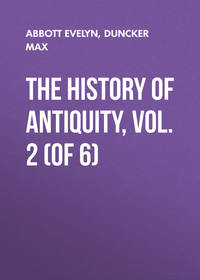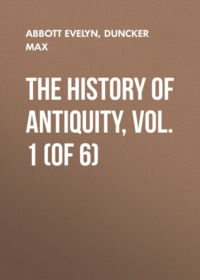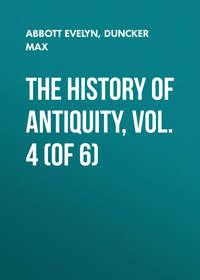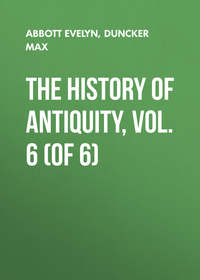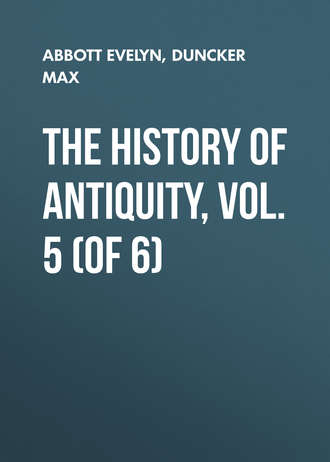 полная версия
полная версияThe History of Antiquity, Vol. 5 (of 6)
95
Above, p. 26. Arrian, "Parth." 2, ed. Müller; Eunap. p. 222.
96
Al Biruni in Droyson, "Hellenismus," 32, 372.
97
Vologeses I. reigned 50-80 A.D.; Vologeses II. 130-149 A.D.; Vologeses III. and IV. 149-208 A.D.; the son of the fourth, also Vologeses, reigned beside Artabanus IV.
98
Joseph. "Ant." 18, 9, 1; "Bell. Jud." Prooem. 1, 2; Ammian. Marcell. 23, 6.
99
Ammian. Marcell. 17, 5.
100
Nöldeke, "Tabari." s. 437.
101
De Sacy, "Memoires de l'institut Cl. Hist." 2, 162-242. [Rawlinson, "Seventh Monarchy," p. 70, 606.]
102
Rawlinson, loc. cit. p. 602, 607, 92 ff.
103
Agathias, 2, 26.
104
Sozomen, "H. Eccl." 2, 10, 12.
105
Menandri Protect. fragm. 11, ed. Müller.
106
[Cf. Rawlinson, "Seventh Monarchy," p. 96 ff.]
107
Spiegel, Avesta, 3, 214, 218, 219, 227.
108
Above, p. 17. On the date of these translations, Haug, "Pahlavi-Pazand Glossary," p. 147.
109
Quatreinère, "Journal des Savants," 1840, p. 412.
110
Haug, "Pahlavi-Pazand Glossary," p. 120 ff.; 128 ff. West, "Pahlavi Texts," part 1. Introd. § 2.
111
Lepsius, "Zendalphabet, Abh. B. Akad." 1862, s. 338; Lenormant, "Sur l'alphabet Pehlevi Journ. Asiat. 1er." 6, 6, 180 ff.; Levy, "Beiträge Z. D. M. G.", 21, 459 ff. From Ardeshir down to Narses, i. e. from 226 to 302 A.D., the writing on the coins agrees with the West Pehlevi of the monuments of the Sassanids. From 302 to 600 A.D. the character on the coins is different. From 600 the writing on the coins agrees with the MSS. of the Parsees; Mordtmann, "Z. D. M. G." 8, 12 ff.
112
Lepsius, loc. cit. s. 306.
113
Westergaard, "Avesta," 1, 4 ff.
114
That the author or authors of the Bundehesh, – for the work consists of a collection of fragments of various character, – had before them larger remains of the Avesta, or a commentary which included more than our fragments, may be conceded. The composition of the work cannot be placed before the time of the Arabs, for the whole period of the Sassanid empire is given, and even on an extended scale (p. 82), mention is made of the empire of the Arabs, and Arabian words occur. Cf. Justi, "Bundehesh," p. ix. ff; cf. below, p. 73. [West, "Pahlavi Texts," 1, Introd. p. xci. ff].
115
On the Aramean sketch of the dialectic of Aristotle which was written for Ohoeru, cf. Renan, "Journ. Asiat." 1852, p. 311.
116
[Cf. Rawlinson, loc. cit. 448 ff.; 342 ff.]
117
"Sharastani," by Haarbrücker, 2, 284. The son of Mihr Narses is called Zarvandadh.
118
[Cf. Darmesteter, "Zend-Avesta," Introduct., c. iv. § 40, and c. iii.]
119
Plato. "Alcib. I." p. 122.
120
Diog. Laert. prooem.
121
Plin. "H. N." 80, 2.
122
1, 94.
123
Justin, 1, 1.
124
"Numa," c. 4; "Quaest. Sympos." 4, 1. [The reading Ζωροάστρην is doubtful; cf. Wyttenbach.]
125
Dio Chrys. 2, 60, ed. Dind.
126
Euseb. "Chron." ed. Auch. p. 43; cf. Georg. Syncell. p. 167. Βάτου after Zoroaster should here be changed into Βάκτρου rather than Μάγου.
127
Arnob. "Adv. Gent." 1, 5.
128
Euseb. loc. cit. p. 35.
129
Porphyr. "De antro nymph." c. 6.
130
Ammian. Marcell. 23, 6.
131
Agathias, 2, 24.
132
Suidas, Μάγοι, Ζωροάστρης.
133
Above, p. 17. Georg. Sync. p. 78, 79. Vol. I. p. 241, 247.
134
Yet with Moses Zoroaster is a Mede, I. p. 87.
135
Plut. "Pomp." c. 24.
136
Cf. Von Gutschmid, "Die Sage vom heiligen Georg;" Sächsische Gesellschaft d. W., 1861, s. 175.
137
"Farvardin Yasht," 131.
138
C. 20 in Justi, [c. 20; § 32 West]; cf. "Vend." 19, 15.
139
C. 30, cf. above, p. 40. [C. 29, § 14, West.]
140
Strabo, p. 515, derives it from Atropates, whom Alexander made satrap there.
141
Still less important than the Bundehesh is the gloss on "Vend." 1, 60. "Many say that Zartusht was from Rak in Atropatan." Ragha is not in Atropatene.
142
Spiegel, "Eran," 1, 684 ff.
143
Plin. "H. N." 30, 2. Diogen. Laert. prooem. The different readings of 500 years in Suidas and 600 in Diogenes, as compared with 5000 and 6000 in the other MSS., can hardly be maintained against the uniform evidence of other witnesses.
144
Plut. "De Isid." c. 47.
145
"Vend." 19, 33; Spiegel, "Avesta," 3, 9, 201, 206.
146
"Ashi Yasht," 17; "Vend." 2, 20 ff.
147
West, "Mainyo-i-Khard," p. x.
148
West, loc. cit. c. 8.
149
Justi, "Bundehesh," c. 1, 3, 34. [Cf. West's commentary on c. 34.]
150
Spiegel, "Eran," 1, 507.
151
Justi, "Bundehesh," c. 34.
152
If the rise of Arsaces is put in the year 250 B.C. It makes no difference in the total if we choose the year 248 B.C. for the beginning of the Arsacids.
153
Blau, "Z. D. M. G." 18, 686. Von Gutschmid, ibid.
154
"Farvardin Yasht," 139.
155
Aristot. "Metaph." 13, 4. Diogen. Laert. prooem.
156
Theopom. Fragm. 71, 72, ed. Müller.
157
Diogen. Laert. prooem., cf. Suidas, Μάγοι.
158
"Alcib. I." p. 121.
159
Plut. "Alex." c. 30.
160
Plut. "Artax." c. 4, 23, 29.
161
"Themistocl." c. 28.
162
Dinon, Fragm. 9, ed. Müller.
163
"Cyri Instit." 8, 1, 21.
164
Herod. 3, 16.
165
Herod. 1, 101, 131-140; 7, 40, 43, 113, 191; 3, 84.
166
Inscription of Darius at Elvend in Spiegel, "Keilinscriften," s. 45, 47.
167
Behistun, 4, 73-80; 56-61; Persop.
168
Strabo, p. 719; Nicol. Damasc. fragm. 66, ed. Müller.
169
Plin. "H. N." 30, 2; 28, 19.
170
"Vita Pythag." 12.
171
Diogen. Laert prooem.
172
Suidas, Μάγοι.
173
Herod. 1, 100, 124, 125.
174
Ezra, c. v., vi.
175
The Niça of the Vendidad is the Eastern Niça, Parthorum Nisæa, not very far from Merv; above, p. 10, n. 1.
176
Lepsius, "Ueber das ursprungliche Zendalphabet," Abh. B. Akad. 1862, s. 298, 306, 381.
177
"Vendid." 4, 120; Astad Yasht, 1.
178
"Gah Ushahin," 5; "Mihr Yasht," 13, 143.
179
"Mihr Yasht," 118.
180
Pouruta may be referred to the Παρυηται of Ptolemy, whom he places in the north of Arachosia.
181
Cf. "Mihr Yasht," 127, where the boar is not Verethraghna but the "curse of the sage."
182
Windischmann, "Mithra; Abhl. für Kunde des Morgenlandes," 1, 1 ff.
183
Haug, "Essays," p. 185. The Sassanids also carry the club now called guzr.
184
"Yasht Bahram," 57-62. Burnouf, "Commentaire sur le Yaçna," p. 285.
185
"Ram Yasht," 43-57.
186
"Aban Yasht," 64 ff.; "Yaçna," 74.
187
Hang, "Essays," p. 179. The passages given in the text from the Aban Yasht, notwithstanding the swelling breasts, shows how definitely the form of Anahita belongs to the Iranian conception, how peculiarly this goddess of fountains is represented in this form, and how intimately connected she is with the whole Iranian system of the boon of water, and the legends of the heroes. A brass tablet found at Grächwyl in the canton of Berne, which exhibits the Persian Artemis with swelling breasts, surrounded by four lions, with a bird of prey on her head and serpents instead of ears, and wings on the shoulders, has decided J. Stickel ("De monumento Graechwyliano") to regard the Persian Artemis as identical with the Semitic goddess of birth. This tablet is due to the syncretism of Roman times. Certain similarities between the Syrian goddess of birth and fertility, Mylitta-Derceto, and the Persian goddess of water, might lead to such a syncretism even under the Achæmenids, and this coincidence might determine Artaxerxes Mnemon to erect images of Anahita in Ecbatana and Susa after the pattern of the Semites. Beros. fragm., 16 ed. Müller, and below.
188
"Tistar Yasht," 24 ff., 40, 49-58.
189
"Yaçna," 56; "Vend." 18, 39.
190
"Vend." 8, 248-250; "Yaçna," 26, 61, 23; "Yasht Farvardin," 77.
191
"Vend." 18, 57-63, 19, 134.
192
Roth, "Ueber Yaçna, 31," Tübingen, 1876, s. 6, 20.
193
"Vend." 19, 135; "Yaçna," 17, 69.
194
"Yaçna," 31, 3, 19.
195
"Yaçna," 9, 10, according to Burnouf, "Journ. Asiat." 1844-1846. Cf. Spiegel "Avesta," 2, 68 ff.
196
"Gosh Yasht," 17; "Mihr Yasht," 88; "Yaçna," 56, 8.
197
"Yaçna," 29; Roth; "Z. D. M. G." 25, 6 ff. Geus urva means soul of the bull; the priests identified the soul of the first created bull with the protectress of the flocks, the Drvaçpa, i. e. having mighty horses. Spiegel, "Avesta," 3, 74.
198
"Aban Yasht," 17-19.
199
"Afrin Zartusht," 4.
200
"Yaçna," 9, 42.
201
"Farvardin Yasht," 93, 94.
202
"Ashi Yasht," 17 ff.
203
"Bahram Yasht," 28-33.
204
"Yaçna," 13, 18; 64, 38; 69, 65.
205
"Vend." 19, 36-137.
206
"Farvardin Yasht," 95.
207
"Yaçna," 28, 9, 44, 45; 46, 1-4; 49, 8; 50, 16, 18, according to Haug's translation, which however has been called in question.
208
"Aban Yasht," 104-106.
209
"Gosh Yasht;" cf. "Ram Yasht," 36; "Farvardin Yasht," 142.
210
"Yaçna," 45, 14 ff.
211
"Farvardin Yasht," 99; "Zamyad Yasht," 84 ff.
212
"Ashi Yasht," 49; "Aban Yasht," 112.
213
"Afrin Zartusht," 1-4.
214
"Yaçna," 52, 3; "Farvardin Yasht," 98.
215
"Yaçna," 9, 46.
216
"Ashi Yasht," 19.
217
"Vend." 3, 23; 19, 1-32, 140-147.
218
"Vend." 1, 46-48.
219
"Vend." 1, 50-52.
220
"Vend." 1, 30-32.
221
"Yaçna," 19, 51, 52; "Vend." 1, 60-62.
222
"Vend." 1, 64-66.
223
"Vend." 1, 9-12, 24; 7, 69.
224
Herodotus states expressly that some tribes of the Persians were nomads (1, 125); beside the Sagartians nomadic tribes are also mentioned among the Carmanians, Areians, etc.
225
"Yaçna," 9, 41; "Ashi Yasht," 20.
226
"Ashi Yasht," 20.
227
"Ashi Yasht," 18.
228
"Yaçna," 56, 3, 1-3.
229
"Yaçna," 28, 29, 42, 43, 44, 46, according to Haug's translation, which is not universally accepted; "Yaçna," 31 after Roth. "Z. D. M. G." 25, 6 ff.
230
"Yaçna," 30, after Hübschmann's rendering.
231
"Yaçna," 33, 8.
232
"Yaçna," 31, 6.
233
"Yaçna," 34, 1.
234
"Yaçna," 50, 7.
235
"Yaçna," 34, 11.
236
"Yaçna," 41, 10, 11; cf. 57, 20.
237
"Yaçna," 43, 18.
238
"Yaçna," 44, 5. The passages in the text concerning Haurvatat and Ameretat are given after Darmesteter, "Haurvatat et Ameretat," p. 35 ff.
239
"Yaçna," 31, 18.
240
"Yaçna," 47, 1.
241
"Yaçna," 47-49, according to Haug's translation.
242
"Yaçna," 31, 3, 19; 33, 3; 46, 7.
243
Plut. "De Isid." 46.
244
From the invocation of the time without limit, Zrvana akarana, in the Avesta (p. 79), some have sought to draw the conclusion, that this is the supreme principle, and that Auramazda and Angromainyu proceeded from it. This is no less incorrect than if it were maintained that according to the Christian dogma God and the devil owed their origin to eternity. In the Avesta Zrvana akarana does not assume an important place either at the creation or in the worship. I have already remarked above, that the spirits of light are called in the Rigveda sons of Aditi, i. e. of the unlimited, the eternal. Parallel similitudes which, however, mean no more than the eternity of the gods, could be made even among the Arians of Iran. But there is a difference between speaking in similes, and derivation from a principle. The faith of Iran was not a philosophical system, but a religion; a religion cannot combine the good and evil god into one unity. It is only when speculation becomes master over religion, that conceptions of this kind can find a place; and this speculation, which sought for primeval cosmical unity, arrived as a fact at an identical origin for the good and evil spirit; but this was not the case with the Avesta. Centuries after the establishment of the canon we find the oldest form of such teaching in a demand made to the Armenian Christians that they should join the faith of Auramazda. In this we are told that the great deity Zrovan had sacrificed for a thousand years, and had received two sons, Ormuzd and Ahriman. The first had created heaven and earth, the other had opposed him with evil works. About the same time Theodorus of Mopsuestia in Cilicia (Phot. "Biblioth." p. 63, ed. Bekker), tells us: "Zoroaster called the creator of all things Zaruam, and described him as fate;" and in the sixth century Damascius ("De prim. princip." p. 384) writes: "The Magi and the whole Arian nation call the Whole and One in thought, space and time respectively; from this One arose the good and evil god, Oromasdes and Areimanius, or as others say light and darkness were divided before these." The sect of the Zarvanites, who deviated from the faith of Zoroaster, inasmuch as they carried these principles still further, has been already mentioned (p. 67).
245
"Mihr Yasht," 123.
246
Ashi vanguhi is in one passage called the daughter of Auramazda and Armaiti; "Yaçna," 44, 4; "Vend." 19, 45; "Ashi Yasht," 16.
247
"Tistar Yasht," 50.
248
"Vend." 19, 40; "Yaçna," 56, 10, 2.
249
"Vispered," 23, 1.
250
"Yaçna," 44, 4; 46, 2; 13, 6; "Vend." 19, 45; Haug, "Essays," p. 231.
251
Spiegel, "Eran," 1, 435.
252
Darmesteter, "Haurvatat et Ameretat," p. 68, 81 ff.
253
"Vend." 19, 30-34, 54.
254
"Din Yasht," 2.
255
"Rashnu Yasht," 8.
256
Burnouf, l. c. p. 417, 468.
257
"Gosh Yasht;" Yaçna, 29; 39, 1.
258
"Vend." 19, 111, 112; 22, 22.
259
Herod. 7, 40, 55; Xenoph. "Cyr. inst." 8, 3, 12; Curtius, 3, 3, 8; 4, 48, 12. Dio Chrysost. 2, 60, ed. Dindorf.
260
p. 732.
261
"Khorshed Yasht," in De Harlez, "Avesta," p. 34.
262
10, 17, 18.
263
"Zamyad Yasht," 96; Darmesteter, l. c. p. 10.
264
"Vend." 18, 38.
265
"Vend." 19, 6, 146.
266
Burnouf, "Journ. Asiatic," 1845, p. 433.
267
"Vend." 10, 23. Windischmann, "Zoroastrische Studien," s. 138.
268
"Vend." 19, 147.
269
"Vend." 4, 139.
270
"Vend." 12, 65, 71; 14, 9 ff.; Plut. "De Isid." c. 46; Agath. 2, 24.
271
Plut. "De Isid." c. 46.
272
"Vend" 18, 34-37; 64-69.
273
Cf. "Bundehesh," c. 19.
274
"Yasht Farvardin," 109; "Yasht Bahram," 19-21.
275
Kuhn, "Herabkunft des Feuers," s. 125; Darmesteter, loc. cit. p. 55. Çinmurv has arisen out of Çaena (Çin), i. e. eagle, and meregha, "bird;" Middle Pers. murv; New Pers. murgh. In New Pers. Çinmurv becomes Simurgh.
276
Isaiah xlvi. 11. In Aeschylus also an eagle represents the Persians and a falcon the Hellenes; "Pers." 205-210.
277
"Cyri instit." 7, 1, 4.
278
3, 7.
279
"Vend." 18, 137, 138, 149.
280
Xenophon, "Cyri instit." 8, 3, 11, 24; Athen. p. 145; Arrian, "Anab." 6, 29.
281
"Yaçna," 10. 38, 11, 16. Strabo, p. 732, tells us that the deity of the Persians received nothing from the sacrifice.
282
What Herodotus tells us of the sacrifice of girls and boys by the Magi in Thrace contradicts his own statement that the Magi did not venture to kill any one, and the whole conception of the Avesta. If Cambyses is said to have caused twelve Persians to be buried alive, this is not to be regarded as a sacrifice, but as a barbarous form of execution, which occurs also under the Sassanids. What Herodotus says of the fourteen boys offered by Amestris as a sacrifice, if true, must have its origin in some other superstition, not in the Avesta; and the actions of Amestris and Parysatis in this direction, as recorded by Ctesias, were in any cases crimes, not sacrifices.
283
Strabo, p. 732.
284
Fragm. 16, ed. Müller.
285
1, 131.
286
Strabo, p. 733.
287
Windischmann has shown, "Abh. Bair. Akad. phil. philol. Kl." 8, 90, 120, that, Ἀμαρδατός must be read for Ἀνανδατός.
288
"Vend." 7, 132-136; 19, 90-100.
289
"Vend." 19, 89.
290
"Vend." 18, 68, 69.
291
"Vend." 19, 108.
292
"Vend." 13, 22, 25.
293
"Vend." 19, 100-108.
294
"Vend." 8, 252, 310; 19, 94; cf. 3, 118-121. In the Dinkart the proceedings on the bridge are related at greater length.
295
Vol. IV., 61, 163, 230.
296
"Farvardin Yasht," 35-48, 70, 71.
297
"Farvardin Yasht," 61, 62.
298
"Farvardin Yasht," 50-52.
299
Diogen. Laert. "Prooem." 6.
300
"Vend." 19, 46, 48.
301
"Yaçna," 1, 47; 23, 6; Burnouf, "Commentaire," p. 571.
302
Plut. "Artax." 15; Theopomp. Fragm. 135, ed. Müller.
303
"Yaçna," 45, 3; 47, 1; above, p. 156.
304
"Vend." 19, 17-19; above, p. 135.
305
"Zamyad Yasht," 89, 95, 96.
306
3, 62.
307
Theopomp. Fragm. 71, 72, ed. Müller.
308
"Yaçna," 19, 16-18.
309
"Yaçna," 26, 32; "Farvardin Yasht," 135.
310
"Aban Yasht," 21-23; "Farvardin Yasht," 157; "Ashi Yasht," 24; "Zamyad Yasht," 26.
311
"Ram Yasht," 11; "Zamyad Yasht," 28.
312
"Vend." 2, 87-89; "Yaçna," 14, 4-6. If in "Yaçna," 19, 46 four occupations are mentioned instead of the four orders, and artisans are added to the husbandmen, this is only another theory, which does not, however, alter the series and system; in India the order of Vaiçyas comprises husbandmen, merchants, and artisans.
313
"Vond." 8, 254.
314
Under the Sassanids we find a chief of the husbandmen (vaçtriosan), and a chief of the warriors (arthestaran); Nöldeke, "Tabari," s. 110.




